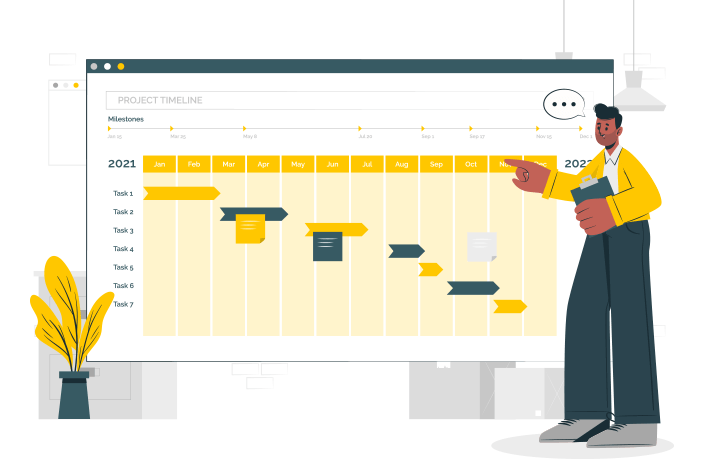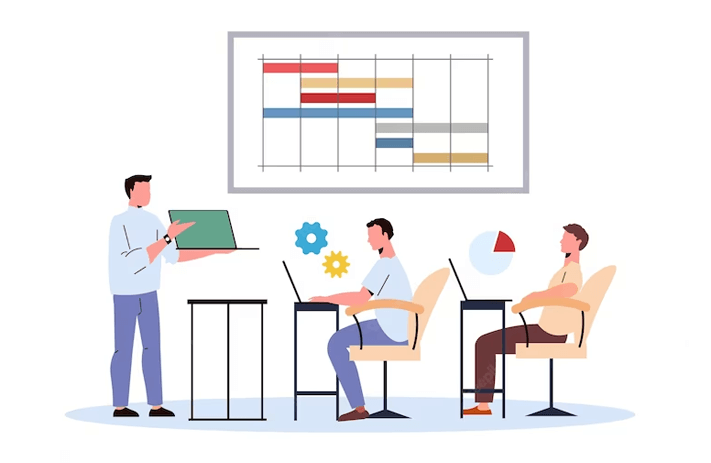
Click the button to start reading
Turbocharging Your Success: A User-Friendly Roadmap to Business Process Analysis
Isn’t it intriguing how some businesses run like well-oiled machines, while others seem to stumble along, constantly dealing with crises? If you’re reading this, there’s a good chance you’re seeking ways to make your business more like the former and less like the latter.
Guess what? You’re in the right place. We’re about to explore a powerhouse tool that can help streamline your business operations and supercharge your efficiency: Business Process Analysis (BPA).

Getting Acquainted with Business Process Analysis
Defining Business Process Analysis: Your Secret Weapon
In your quest for business efficiency, you’ve likely come across many tools and strategies. But let’s cut through the jargon and get to the heart of the matter. Business Process Analysis, or BPA, is a systematic review of your business operations to uncover inefficiencies and identify opportunities for improvement.
Remember those well-oiled machines we mentioned earlier? Well, consider BPA your mechanic. It looks under the hood, identifies what’s working and what’s not, and makes recommendations to get all parts running smoothly.
But why is it essential? Imagine running a race with a pebble in your shoe. You might still finish, but wouldn’t it be easier (and less painful) without the pebble? BPA helps you find and remove those metaphorical pebbles that slow your business down.
Not Everything is BPA: Clearing up the BPA vs. BA Confusion
Hold on a minute. You’ve heard about Business Analysis (BA) too, right? And you’re wondering if it’s the same as Business Process Analysis. It’s a common confusion, so let’s clear that up.
While BPA and BA might seem like identical twins, they’re more like cousins. Business Analysis is a broader discipline that looks at all aspects of a business to identify problems and recommend solutions. It can touch on anything from marketing strategies to hiring practices.
On the other hand, BPA is a bit more specialized. It zeroes in on your business processes—those step-by-step methods your team follows to get things done. It’s like a detective gathering evidence (data) to find out how things work and where the issues lie.
So while both BPA and BA are crucial, they play different roles. BPA digs deep into your processes, while BA takes a wider view. Knowing the difference can help you apply the right tool at the right time.
In the following sections, we’ll delve deeper into the world of BPA, from knowing when to use it to master its techniques. We’ll also explore its benefits and even recommend some tools that can give your analysis a boost. So, stick around, and let’s get you on the path to becoming a BPA pro.

The Perfect Time for BPA: When Should You Dive In?
It’s just like when your car makes that odd clicking noise. You don’t wait until it breaks down in the middle of a road trip to see the mechanic, do you? Just as you’d listen to your car’s subtle signs of distress, your business also sends signals that it’s time for a BPA. Let’s decipher them together, shall we?
Is Your Process Feeling Ill?
No, your business process doesn’t literally fall ill, but it can certainly exhibit symptoms of inefficiency.
So, what are these signs?
- If your team’s productivity is dwindling and tasks are piling up, your process might need a check-up.
- If you’re consistently missing deadlines and quality is taking a hit, it’s time for a process review.
- If employees are expressing frustration with cumbersome, confusing workflows, you might have a problem.
These are just a few signs that it’s time to roll up your sleeves and dive into a BPA.
Ready to Automate? Check with BPA First!
You’re thinking about automating your processes, right? That’s a smart move. But before you sprint towards automation, remember to tie your shoelaces. Why? You wouldn’t want to trip and fall flat, would you?
By shoelaces, we mean a well-executed BPA. Diving headfirst into automation without a solid understanding of your processes is like trying to make a cake without a recipe. Sure, you might end up with something cake-ish, but wouldn’t it be better to follow a tried-and-true recipe? A thorough BPA before automation ensures that you’re automating a process that’s efficient and effective, not one that’s full of flaws.

The Nuts and Bolts: How Does BPA Work?
Now that we’ve discussed when to consider BPA let’s talk about how to conduct one. You might be picturing a colossal, tangled web of steps, but don’t worry—it’s not as daunting as it sounds. Let’s break it down.
1. Picking the Right Process: Your First Step to BPA Success
Where do you start with BPA? Simple. Identify the process that’s causing you the most grief. It could be your customer service process, your order fulfillment workflow, or your employee onboarding procedure. Don’t feel like you need to overhaul everything at once. Remember, even a small change can have a ripple effect across your entire business.
2. Your BPA Treasure Hunt: Collecting Crucial Process Information
Now that you’ve picked a process to analyze, it’s time to gather all the information you can about it. This step is like a treasure hunt—except instead of gold, you’re after information.
Ask your team members involved in the process for their insights and experiences. Look at any data you’ve collected about the process, such as time taken, costs incurred, or errors made. Remember, the more information you gather, the clearer your understanding will be.
3. Dissecting the ‘As-Is’ Process: The Heart of BPA
You’ve collected all this great information—now what? Now it’s time to map out your process as it currently stands, often called the ‘As-Is’ process.
Consider this stage the heart of your BPA. It’s where you’ll identify bottlenecks, redundancies, and other inefficiencies. You’ll measure your process’s effectiveness and determine where improvements can be made.
4. Envisioning the Future: Crafting Your ‘To-Be’ Process
You’ve dissected your ‘As-Is’ process, and now you’re left with a pile of data and insights. Your next step? Use this information to craft your optimized future process, or ‘To-Be’ process. This is where you’ll identify solutions to the issues you’ve uncovered, design improvements, and envision how your process will flow in the future.

BPA Techniques: The Secret Sauce of Your Analysis
Just like in cooking, every dish requires a unique mix of ingredients and techniques. Business Process Analysis is no different. Here’s a look at some common techniques that add flavor to your BPA – the secret sauce, if you will.
Filling the Gaps: Your Guide to Gap Analysis
Remember that road trip you took where your GPS lost signal, and you found yourself on a desolate road with no idea where you were? That’s what running a business without gap analysis is like.
Gap analysis is a technique where you compare your current state (where you are) to your desired state (where you want to be). It helps you identify the ‘gaps’ in your process and provides a roadmap to reach your business goals.
Think of it as your business’s GPS, guiding you from your ‘As-Is’ process to your ‘To-Be’ process without taking detours down roads leading nowhere.
Rooting Out the Issues: The Power of Root Cause Analysis
There’s a story of a gardener who, every day, noticed new weeds sprouting in his garden. He kept pulling them out, but they kept coming back. Why? Because he was dealing with the symptoms, not the root cause.
Root Cause Analysis (RCA) is about finding the root of your process problems, not just addressing the symptoms. By understanding the underlying causes of issues, you can solve problems at their core, preventing them from recurring. RCA is like a garden hoe that helps you dig deeper and eliminate those pesky business process weeds for good.

Supercharge Your BPA: Tools to Boost Your Analysis
Imagine trying to bake a cake without a mixer, an oven, or a recipe. It’s possible, but it’s going to be a tough slog, right? That’s where BPA tools come in – they’re the kitchen appliances of your process analysis.
BPA Superheroes: Why You Need Tools Like Nintex and Kissflow
Let’s talk about some of the power tools in the BPA toolkit. Nintex and Kissflow, for instance, are like the Swiss Army knives of process analysis. They offer a range of features, from process mapping to workflow automation.
When selecting a tool, consider your unique needs. What’s the scale of your processes? What’s your budget? What features are a must-have for you? A little research will go a long way in picking the right tool for your needs.
The Big Wins: Unleashing the Benefits of BPA
You’ve spent a lot of time analyzing, adjusting, and perfecting your processes. Now it’s time to enjoy the fruits of your labor. Or should we say, the big wins?
Say Hello to Clear Documentation and Robust Data
One of the major wins of BPA is clarity – crystal clear documentation of your processes and robust data to back your decisions. You’ll have a clearer understanding of how your business operates and what areas need improvement. It’s like having a detailed map of your business landscape, enabling you to navigate efficiently and make informed decisions.
Spotting the Trouble Makers: Identifying Process Obstacles
Another significant win is the ability to spot and overcome process obstacles. Think of it as being gifted with x-ray vision to see through your processes and identify bottlenecks, redundancies, and inefficiencies.
There’s a sense of achievement that comes with finding these troublemakers and resolving them. It’s not unlike finally finding where that odd noise was coming from in your car and fixing it. The ride’s smoother, the stress is lower, and your journey toward business efficiency becomes more enjoyable.
Conclusion: Your Next Steps in Mastering BPA
Well, it’s been quite the journey, hasn’t it? You’ve cruised through the landscape of Business Process Analysis, picking up essential insights, tips, and techniques along the way. But remember, understanding BPA isn’t the finish line; it’s the starting point of a grand adventure towards process efficiency.
So what’s next on the agenda for you?
Perhaps it’s time to take those newly acquired BPA skills and insights and give them a whirl. Maybe there’s a process in your organization that’s been a thorn in your side, something that’s been bothering you and your team for a while. Why not start there? Put your BPA cap on and start your gap analysis. Or maybe you’ve spotted a potential troublemaker? Time to whip out your root cause analysis skills.
Remember, you’re not alone on this journey. There are tools out there, like Nintex and Kissflow, ready to give you a helping hand. And, of course, there’s always room for learning more, improving, and refining your skills.
So go on, roll up your sleeves, and dive into the world of Business Process Analysis. There’s a whole realm of process efficiency waiting to be unlocked, and you’ve got the master key.
Remember, success isn’t a destination; it’s a journey. And with BPA, you’re sure to have one exciting ride.
















